Cell Theory & Types of cells | Biology Class 11 - NEET PDF Download
| Table of contents |

|
| What is a Cell? |

|
| Cell Theory |

|
| An Overview of Cell |

|
| Size and Shape of Cells |

|
| Types of Cells |

|
When observing the world around us, we encounter both living and non-living entities. A question that arises is what distinguishes living organisms from non-living objects. The key lies in the presence of cells, the fundamental unit of life, which is found in all living organisms. Living organisms are made up of cells, with some being unicellular, consisting of just one cell, while others, such as humans, are multicellular, comprising multiple cells.
What is a Cell?
Unicellular organisms possess the ability to exist autonomously and carry out vital life functions. Without a fully formed cell structure, independent living is not possible.
Thus, the cell stands as the fundamental building block and operational unit of all living organisms.
Anton Von Leeuwenhoek was the first to observe and describe live cells, while Robert Brown identified the nucleus. Advancements in microscopy, especially with the electron microscope, revealed the detailed structure of cells.
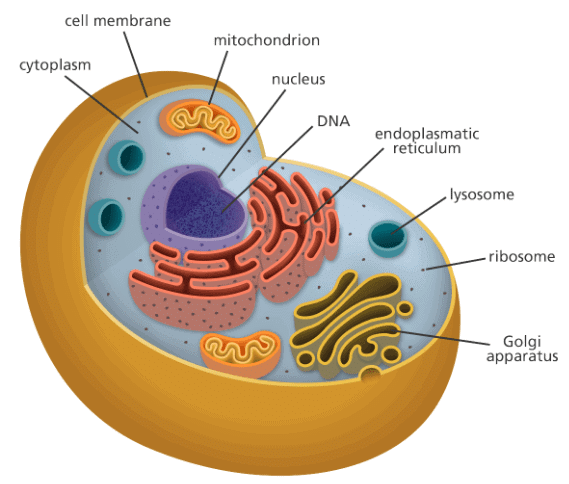 Structure of Cell
Structure of Cell
Cell Theory
In 1838, Matthias Schleiden, a German botanist, discovered that plants are composed of various types of cells, forming the plant issue. Around the same time, Theodore Schwann, a British Zoologist, identified a thin outer layer in animal cells, known today as the 'plasma membrane.' Schwann also concluded that plant cells possess a unique feature, the cell wall, based on his studies of plant tissues. Schwann proposed the hypothesis that both animal and plant bodies are constructed from cells and their products.

Schleiden and Schwann collaborated to formulate the cell theory, which initially lacked an explanation for cell formation.
Rudolf Virchow, in 1855, provided the missing explanation by demonstrating that cells divide and give rise to new cells from pre-existing ones ("Omnis cellula-e cellula").
Virchow's work refined the cell theory, establishing two key principles:
All living organisms are composed of cells and their products.
All cells originate from pre-existing cells
An Overview of Cell
- Onion cells, typical of plant cells, are characterized by a distinct cell wall as the outer boundary, followed by the cell membrane.
- Human cheek cells have an outer membrane as the defining structure, enclosing a dense membrane-bound nucleus containing chromosomes and DNA.
- Eukaryotic cells possess membrane-bound nuclei, while prokaryotic cells lack such a feature. Both types of cells contain cytoplasm, a semi-fluid matrix where cellular activities take place.
- Eukaryotic cells additionally contain membrane-bound organelles like the endoplasmic reticulum, golgi complex, lysosomes, mitochondria, microbodies, and vacuoles, which are absent in prokaryotic cells.
- Ribosomes, non-membrane bound organelles, are present in all cells, located in the cytoplasm, chloroplasts (in plants), mitochondria, and rough endoplasmic reticulum.
- Animal cells possess the centrosome, another non-membrane-bound organelle aiding in cell division.
Size and Shape of Cells
Cells vary in size, with Mycoplasma being the smallest at 0.3 µm, bacteria ranging from 3 to 5 µm, and the ostrich egg being the largest isolated single cell.
Human red blood cells have a diameter of about 7.0 µm, while nerve cells are among the longest.
Cells exhibit diverse shapes, such as disc-like, polygonal, columnar, cuboid, thread-like, or irregular, often corresponding to their specific functions.
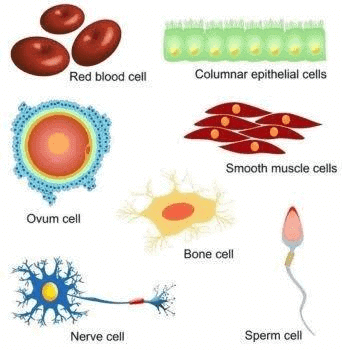
Types of Cells
1. Prokaryotic Cells
A prokaryotic cell is a single-celled or unicellular organism that has neither a true nucleus nor membrane-bound organelles. Organisms belonging to the Bacteria and Archaea domains are based on the prokaryotic cell. Prokaryotic cells are covered with a cell membrane which acts as an extra layer of protection.
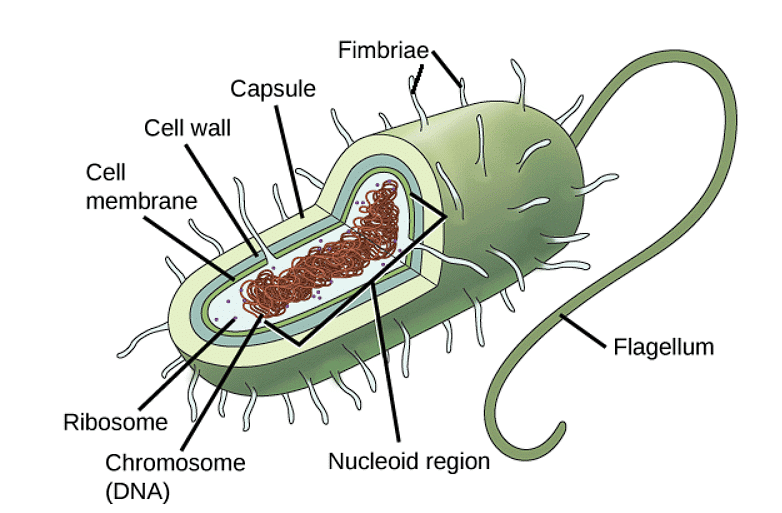
General Characteristics of Prokaryotic Cell
- Prokaryotic cells, such as bacteria, blue-green algae, mycoplasma, and PPLO, are generally smaller and reproduce more quickly than eukaryotic cells.
- Bacteria come in various shapes like bacillus (rod-like), coccus (spherical), vibrio (comma-shaped), and spirillum (spiral).
- Prokaryotic cells have a cell wall surrounding the cell membrane, except for mycoplasma. The cytoplasm fills the cell with no distinct nucleus.
- The genetic material in prokaryotes is not enclosed by a nuclear membrane and includes genomic DNA (a single chromosome/circular DNA) and sometimes extra circular DNA called plasmids.
- Plasmid DNA in bacteria can provide unique traits, like antibiotic resistance. In eukaryotes, a nuclear membrane is present, unlike in prokaryotes.
- Prokaryotic cells lack organelles except for ribosomes but have inclusions and a specialized cell membrane infolding called mesosome.
Cell Envelope and its Modifications
- Most prokaryotic cells, particularly bacterial cells, have a chemically complex cell envelope.
- The cell envelope consists of a tightly bound three-layered structure i.e., the outermost glycocalyx followed by the cell wall and then the plasma membrane.
- Although each layer of the envelope performs a distinct function, they act together as a single protective unit.
- Bacteria can be classified into two groups on the basis of the differences in the cell envelopes and the manner in which they respond to the staining procedure developed by Gram viz., those that take up the gram stain is ,Gram-positive and the others that do not are called Gram-negative bacteria.
- Glycocalyx differs in composition and thickness among different bacteria. It could be a loose sheath called the slime layer in some, while in others it may be thick and tough, called the capsule.
- The cell wall determines the shape of the cell and provides a strong structural support to prevent the bacterium from bursting or collapsing.
- The plasma membrane is selectively permeable in nature and interacts with the outside world. This membrane is similar structurally to that of the eukaryotes.
- A special membranous structure is the mesosome which is formed by the extensions of plasma membrane into the cell.
- Bacterial cells exhibit various extensions and surface structures that play crucial roles in their functions and interactions with the environment. These include vesicles, tubules, lamellae, flagella, pili, and fimbriae.
Membranous Extensions
- Vesicles: Small membrane-bound sacs involved in transport and storage within the cell.
- Tubules: Thread-like structures that may play a role in various cellular processes.
- Lamellae: Flattened membrane structures that assist in functions like respiration and secretion.
- Chromatophores: Membranous extensions found in some prokaryotes like cyanobacteria, containing pigments for photosynthesis.
Flagella
- Flagella are thin, filamentous extensions from the bacterial cell wall that enable motility. The bacterial flagellum consists of three parts:
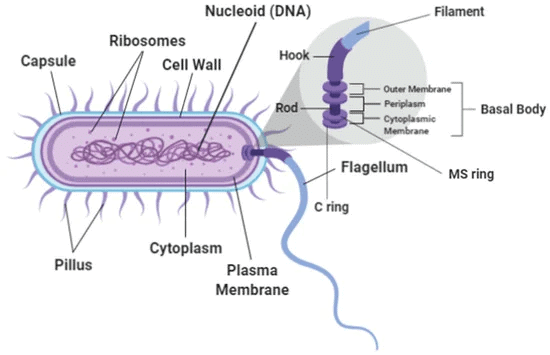 Structure of Bacterium Flagellum
Structure of Bacterium Flagellum Parts of Bacterium Flagellum
Parts of Bacterium Flagellum
Pili and Fimbriae
- Pili: Elongated, tubular structures made of a special protein, involved in various functions such as DNA transfer and adherence.
- Fimbriae: Small, bristle-like fibers that help bacteria attach to surfaces, such as rocks in streams or host tissues.
Ribosomes and Inclusion Bodies
- In prokaryotes, ribosomes are associated with the plasma membrane of the cell.
- They are about 15 nm by 20 nm in size and are made of two subunits - 50S and 30S units which when present together form 70S prokaryotic ribosomes.
- Ribosomes are the site of protein synthesis.
- Several ribosomes may attach to a single mRNA and form a chain called polyribosomes or polysome.
- Inclusion bodies: Reserve material in prokaryotic cells are stored in the cytoplasm in the form of inclusion bodies.
- These are not bound by any membrane system and lie free in the cytoplasm, e.g., phosphate granules, cyanophycean granules, and glycogen granules.
- Gas vacuoles are found in blue-green and purple and green photosynthetic bacteria.
2. Eukaryotic Cells
Any cell or organism with a clearly defined nucleus is called a eukaryotic cell. A eukaryotic cell has a nuclear membrane that surrounds the nucleus and contains well-defined chromosomes. Eukaryotic cells also contain organelles, including mitochondria, Golgi apparatus, endoplasmic reticulum, and lysosomes
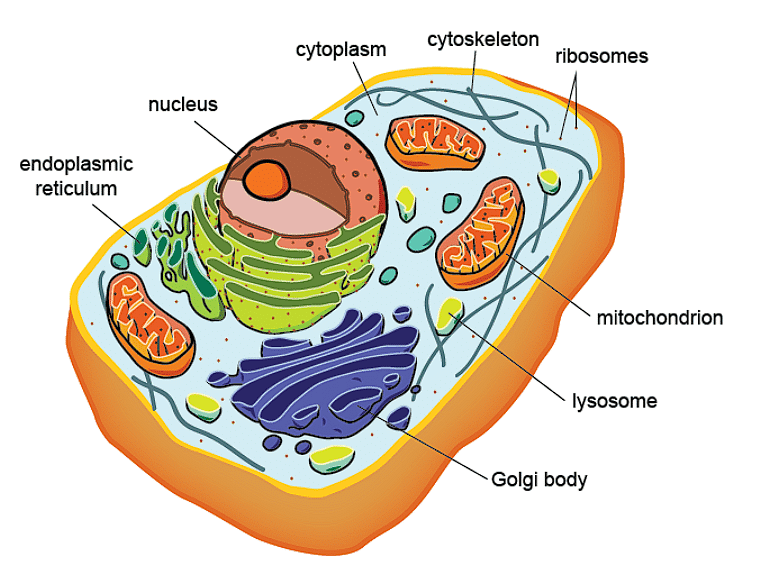
Characteristics of Eukaryotic Cell
- The eukaryotes include all the protists, plants, animals, and fungi.
- In eukaryotic cells, there is an extensive compartmentalization of cytoplasm through the presence of membrane-bound organelles.
- Eukaryotic cells possess an organized nucleus with a nuclear envelope.
- In addition, eukaryotic cells have a variety of complex locomotory and cytoskeletal structures.
- Their genetic material is organized into chromosomes.
- All eukaryotic cells are not identical. Plant and animal cells are different as the former possess cell walls, plastids, and a large central vacuole which are absent in animal cells.
- On the other hand, animal cells have centrioles which are absent in almost all plant cells.
|
150 videos|399 docs|136 tests
|
FAQs on Cell Theory & Types of cells - Biology Class 11 - NEET
| 1. What is a cell and why is it important in biology? |  |
| 2. What are the main points of cell theory? |  |
| 3. How do the size and shape of cells vary among different types of cells? |  |
| 4. What are the different types of cells in living organisms? |  |
| 5. How does the structure of a cell relate to its function? |  |
















